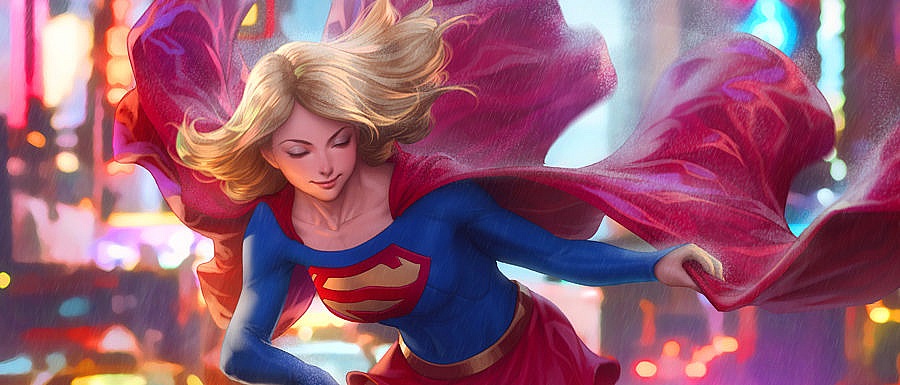Unpublished Supergirl Covers by Amy Reeder
Supergirl #61 and #62 were both solicited with covers by Amy Reeder that didn’t make it to print. The shift in storyline when James Peaty took over from Nick Spencer meant that Batgirl, Static, and Impulse didn’t make it in, so new covers had to be produced. Shown below are the covers that were originally solicited, followed by the covers that were published.
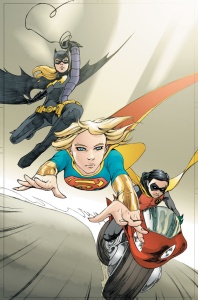 SG #61 – unpublished |
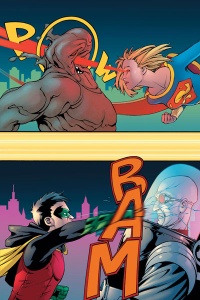 SG #61 – published |
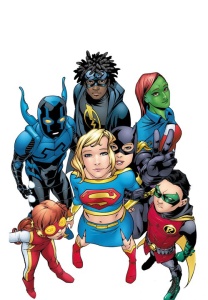 SG #62 – published |
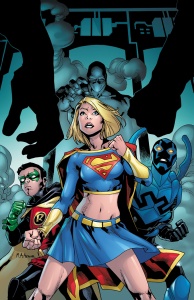 SG #62 – published (Mahmud Asrar) |
I’m sad that we’ll never get to see the original Supergirl #62 starring Kara’s own Justice League. Batgirl hugging her best friend and the adorable Iris West (the new Impulse) clutching Kara’s wrist bring a girl-friendship vibe to the book that rarely appears in DC Comics. I love the shoujo manga influence that Amy Reeder brings to all her Supergirl covers.
Amy Reeder discussed the Supergirl #61 cover, and the process of cover art in general, in a panel at WonderCon 2011 last month.
“I like spending a lot of time on covers, and this one I got to ink and color, which is rare for me. I get a huge, huge rush out of that; I’m always happy when I’m doing everything.”
[Bill] Sienkiewicz asked, “With the covers, do you find there are times when you like the sketch better than the finish?”
“Yeah. A lot,” Reeder said. “Especially if I do a color sketch, ’cause it’s usually because I have a big concept going on, and I don’t end up coloring it anyway. It’s hard to communicate it, so sometimes I’ll color all the sketch and either I won’t do it or [the colorist] will do it so literally that [I feel like] ‘I was gonna make it more complex than that,” That’s the longest part of my process, and he can’t be expected to take, like, three days to color a cover.”
Reeder was more pleased with Supergirl #61. “I had to redo this cover, because DC changed the characters that were going to be in this issue. We were trying to come up with things [because] they wanted me to do more action. I wasn’t doing enough action, so I just went totally, all the way,’ throwback’ — oh, and by the way, this is copying Frank Quitely. I’m sure you were inspired by other things, too, but I really liked how you were doing that in both ‘Batman and Robin’ and ‘Shimura,’ and it made me think about it a little more.” She said, though, “I hate ‘BAM’ on the bottom. It was terribly done; I’m really bad at type, but I work from the bottom right to the top left of pages because I’m a lefty and I smear and stuff, so the ‘Pow’ was better, because I had more time to think about it and wanted to not do badly again.”
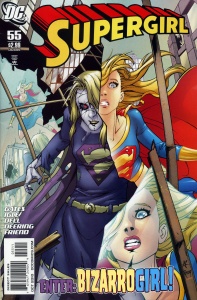
Next, Supergirl #55: “This was the first ‘Supergirl’ cover I did, and I’m really, really proud of it. I lucked out, I guess, on these [cover examples], ’cause there’s definitely things I’m not proud of,” Reeder said. She added that DC gave her some liberties with the new Bizarro Supergirl, including the gawkiness and cracked porcelain skin. “What I really like best about it is that I have all these opposing forces going on, because Supergirl’s hair’s blowing up, Bizarrogirl’s hair’s down; Supergirl’s eyelashes at the top are really big, and Bizarro has a lot of black in the opposite corner of her eye; and their capes are doing opposing things. That was, like, almost accidental. Usually when I do really good things, they’re accidental.”
Earlier in the panel the moderator, Mark Evanier, asked the artists which role they preferred: doing covers without doing interiors, or vice versa.
“I guess I’d rather do both,” Reeder responded. She added, though, that she liked having an alternate interpretation of a character that a cover artist can provide. “A lot of the time, the cover artists are — not in my case, but like in Adam [Hughes]’s — more detailed; it almost makes you feel like you can picture them in real life, and that’s very exciting. You almost forward that on the art you see in the interior, which is pretty exciting.
Reeder confessed that she is relatively new to comics even as a reader, having only begun reading manga toward the end of her college years and tuning into Western comics when she started with DC, and noted that from that perspective have a different artist on covers can be jarring. “As an outsider, I think that it does limit bringing people into comics. That’s the one thing that’s hard for me, so I’m just one of those people who prefer to do it all, and that would include covers.
“I can see both sides is all I’m saying,” Reeder continued, “since I’m very, very keen on getting new readers in…”
Evanier then began a new topic, saying, “I was in comics a long [time] before you read them, and back then there was this frightening attitude in the companies that ‘Supergirl looks this way. She only looks this way,’ until they made a conscious decision to change the character. You don’t have that kind of rigidity anymore. If they went back to that, could you function in that environment?”
Reeder said that she “would not function in that environment, because there are certain designs that I’m not happy with.”
Mark Evanier began working in comics in 1969 and with DC in 1971, so I believe he’s referring to the rigid company style for Supergirl during Silver Age, and the metamorphosis in her character starting in Adventure Comics #397, Sep 1970.
When Evanier asked the panel how often they drew covers without knowing the story inside, Francis Manapul confirmed that’s the norm for him (Bill Sienkiewicz, on the other hand, said that they always send him the script).
“Probably 100% of the time,” Manapul said. “I’ve done covers for books that I’ve had no idea what the story’s about. You’re just like, ‘Hey, well, what is the story about?’ ‘We don’t know yet, it’s not written.’ ‘Well, give me the broad strokes.'”
Credit to Amy Reeder for sharing the SG #62 cover, which I found at Supergirl Comic Box Commentary. The original pencilled and inked piece can be purchased from Reeder, along with three other pieces, at Comic Art Fans.
